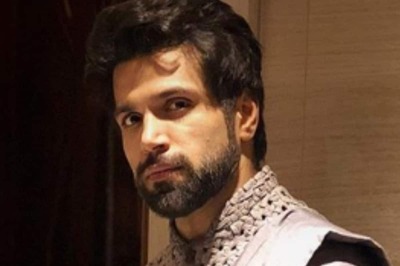
views
The rollout of the National Education Policy (NEP) 2020 was the third significant revision of the education framework in India after the education policies of 1968 and 1986. The new education policy emphasises having a seamless connection between academics, extracurricular activities and vocational learning at the school level. It aims to achieve this through a new curricular and pedagogical structure which incrementally provides interactive learning. Based on the student’s age, this structure is divided into four stages — foundational, preparatory, middle and secondary.
The foundational and preparatory stage aims to build the student’s fundamental literacy and numeracy skills. And the middle and secondary stage plans to provide multi-disciplinary study through experiential learning. This promising reform can set up the foundations for the educational framework in the fourth industrial era. This era will be modelled by frontier technologies like artificial intelligence (AI), Internet of Things (IoT), big data, blockchain, 5G, 3-D printing, etc. Summarily, these technologies will intelligently automate work and need new skills beyond literacy, numeracy and technical know-how.
The World Economic Forum’s (WEF) Future of Jobs report identifies skills like cognitive flexibility, complex problem-solving, critical thinking, creativity, people management, emotional intelligence, coordinating with others, judgement and decision-making, negotiation, and service orientation, which will help one thrive in the fourth industrial era. Such skills are categorised as transversal by noted human development economist, Santosh Mehrotra. The Utthishta Bharat (UB) model lays down an operational framework to fulfill the objectives of NEP 2020 in the larger context of teaching transversal skills to middle-stage students aged 11-14 years of school in India.
The 42nd Constitutional Amendment brought education under the concurrent list. This gives it the unique advantage of having localisation of a state while having national standardisation. To take this forward, the UB model first identifies the strongest industry sectors in a state and studies which frontier technology will be used in these sectors. Curriculum design is the next step after identifying the application of technologies in these economic sectors. The curriculum will be designed in consultation with industry experts, SCERT, and the state’s skill development mission.
The UB model proposes a Massive Open Online Course (MOOC) channel for delivering the content to middle-stage students aged 11-14 who may be studying in classes 6-9. Every year two sectors of the economy can be taken up during these four years of pedagogy. The UB model proposes the distribution of tablets for students to access the interactive content. Students can view the content at their convenience, either at school or at home. But content is just half the learning. There needs to be a guide for students to explain and resolve doubts related to the content.
The UB model recognises that school teachers — government and private — are overburdened with academic and official duties. So, the UB model introduces ‘Margadarshak’, an internal stakeholder of the education ecosystem. Margadarshaks are undergraduate students who visit a nearby school once a week to engage students in discussions about the MOOC content and resolve their doubts. If the agriculture sector is being discussed, Margadarshak can be a BSc Agriculture student. Margadarshaks will receive a stipend pegged at the state government’s matriculation but not graduate pay grade. They will also receive a letter recognising their service to the education ecosystem signed by the local district magistrate.
Assessments are a crucial step in ensuring learning. The NEP 2020 aims to reform examinations in a way in which students’ critical thinking and problem-solving abilities are tested. Keeping this in mind, the UB model proposes a ‘Kalpana Pratiyogita’. As part of this evaluation, students will select a sector they have learned about in the previous year and locate a real-world issue in their community that can be resolved by utilising frontier technology applications they have learned through the MOOC curriculum. The Margadarshaks will evaluate the solutions proposed by students. The local district magistrate will then give the best project under every sector a ‘Kalpana Puraskar’.
It is also necessary to evaluate whether this new-age industry-oriented curriculum and pedagogy is being implemented according to plan. So, to monitor the implementation, the UB model proposes a new type of stakeholder — a ‘Setuka’. Setuka will visit the schools where the UB program is being implemented and track the pre-determined learning parameters by interacting with the school administration, students and Margdarshak.
Surely a question arises here — who is going to overlook this activity? So, let us introduce you to the components of the UB model. This model consists of structural, procedural and behavioural components.
For the structural component, the UB model proposes to set up an expert think-tank under the Department of School Education of the state government. This think tank will have three committees, one each for content design, evaluation and outreach. The committee on content design is responsible for creating the industry-oriented curriculum. It will have representatives from SCERT and the state’s industry bodies. The committee for evaluation will have representatives from the Department of School Education, the Department of Higher Education of the state and a new stakeholder called the Setuka. The committee for awareness will generate awareness about the fourth industrial revolution and frontier technologies within the student community and parents. It will have representatives from the Directorate of Public Relations of the state government, an esteemed business school and parents’ associations of the state.
The procedural component of the UB model mainly consists of a management information system (MIS) that serves two purposes. Firstly, it is a learning portal for school students and a training portal for Margadarshaks and Setukas. Secondly, it is an analytical platform for the UB program. The analysed data will be provided to the committee for evaluation on a periodical basis. This will ensure real-time tweaking of the system if the need arises. The behavioural component comprises the pedagogy that was explained in the earlier part.
Implementing the UB model will bring the industry to framing the school curriculum for the first time. This will then become the first step for the industry to model the workforce according to future needs. The students will realise the importance of application-based learning, making them effective professionals later. This model also harnesses the internal capabilities of the educational ecosystem and avoids laying any more burden on the school teachers. Overall, the UB model seeks to take forward Prime Minister Narendra Modi’s message of ‘Reform, Perform and Transform’ in the field of education.
This model was jointly developed by Suryapratap Babar, Muskan Gupta and Suhail Nazir. They are currently pursuing MBA from IIM Udaipur.
Divya Singh Rathore is a public policy professional. She tweets @_divyarathore; Suryapratap Babar is a public policy enthusiast. He tweets @SuryapratapBab3. Views expressed in the above piece are personal and solely that of the author. They do not necessarily reflect News18’s views.


















Comments
0 comment